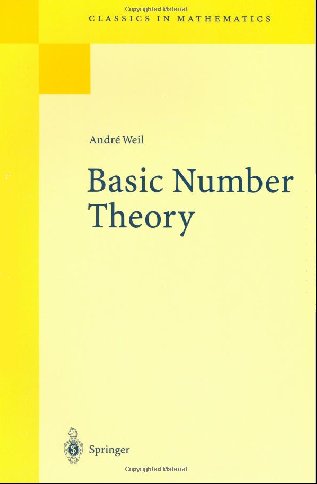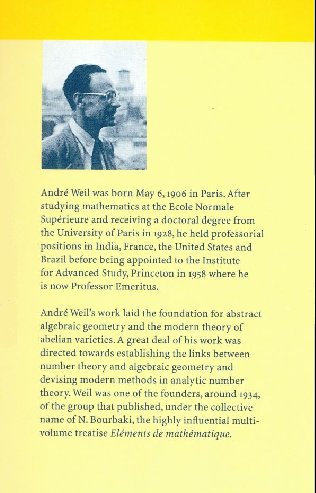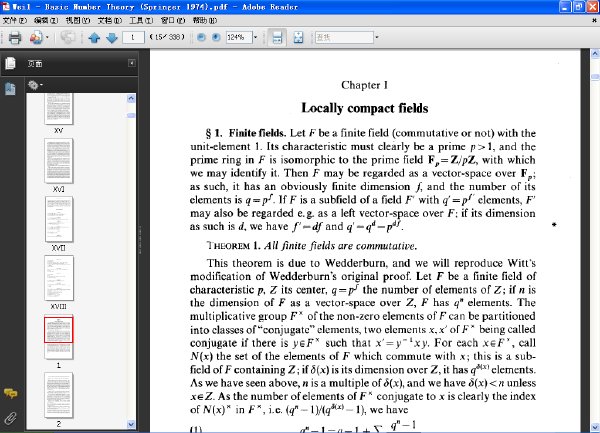《基礎數論》(Basic Number Theory)(Andre Weil)掃描版[PDF] 簡介: 中文名 : 基礎數論 原名 : Basic Number Theory 作者 : Andre Weil 資源格式 : PDF 版本 : 掃描版 出版社 : Springer 書號 : 3540586555 發行時間 : 1995年 地區 : 美國 語言 : 英文 簡介 : 內容簡介 : 本書是一部學習“類域論”的非常好的教材。學習本書不需要任何數論的基礎知識
電驢資源下載/磁力鏈接資源下載:
- 下載位址: [www.ed2k.online][Basic.Number.Theory].Weil.(Springer.1974).pdf
- 下載位址: [www.ed2k.online][Foundations.Of.Algebraic.Geometry].(Andre.Weil,.1946).Ams.pdf
- 下載位址: [www.ed2k.online][Number.Theory.An.Approach.Through.History].Weil.djvu
全選
"《基礎數論》(Basic Number Theory)(Andre Weil)掃描版[PDF]"介紹
中文名: 基礎數論
原名: Basic Number Theory
作者: Andre Weil
資源格式: PDF
版本: 掃描版
出版社: Springer
書號: 3540586555
發行時間: 1995年
地區: 美國
語言: 英文
簡介:


內容簡介:
本書是一部學習“類域論”的非常好的教材。學習本書不需要任何數論的基礎知識,但需要熟知局部緊Abel環,Pontryagin對偶性以及群上的Haar測度的標准定理。此外,本書不適於代數數論的初學者使用。
Review
"L.R. Shafarevich showed me the first edition in autumn 1967 in Moscow and said that this book will be from now on the book about class field theory. In fact it is by far the most complete treatment of the main theorems of algebraic number theory, including function fields over finite constant fields, that appeared in book form. The theory is presented in a uniform way starting with topological fields and Haar measure on related groups, and it includes not only class field theory but also the theory of simple algebras over local and global fields, which serves as a foundation for class field theory. The spirit of the book is the idea that all this is asic number theory' about which elevates the edifice of the theory of automorphic forms and representations and other theories.
To develop this basic number theory on 312 pages efforts a maximum of concentration on the main features. So, there is absolutely no example which illustrates the rather abstract material and brings it nearer to the heart of the reader.
This is not a book for beginners. This book is written in the spirit of the early forties and just this makes it a valuable source of information for everyone who is working about problems related to number and function fields."
Zentralblatt MATH, 823
內容截圖:

目錄:
Chronological table
Prerequisites and notations
Table of notations
PART I. ELEMENTARY THEORY
Chapter I. Locally compact fields
1. Finite fields
2. The module in a locally compact field
3. Classification of locally compact fields
4. Structure of p-fields
Chapter II. Lattices and duality over local fields
1. Norms
2. Lattices
3. Multiplicative structure of local fields
4. Lattices over R
5. Duality over local fields
Chapter III. Places of A-fields
1. A-fields and their completions
2. Tensor-products of commutative fields
3. Traces and norms
4. Tensor-products of A-fields and local fields
Chapter IV. Adeles
1. Adeles of A-fields
2. The main theorems
3. Ideles
4. Ideles of A-fields
Chapter V. Algebraic number-fields
1. Orders in algebras over Q
2. Lattices over algebraic number-fields
3. Ideals
4. Fundamental sets
Chapter VI. The theorem of Riemann-Roch
Chapter VII. Zeta-functions of A-fields
1. Convergence of Euler products
2. Fourier transforms and standard functions
3. Quasicharacters
4. Quasicharacters of A-fields
5. The functional equation
6. The Dedekind zeta-function
7. L-functions
8. The coefficients of the L-series
Chapter VIII. Traces and norms
1. Traces and norms in local fields
2. Calculation of the different
3. Ramification theory
4. Traces and norms in A-fields
5. Splitting places in separable extensions
6. An application to inseparable extensions
PART II. CLASSFIELD THEORY
Chapter IX. Simple algebras
1. Structure of simple algebras
2. The representations of a simple algebra
3. Factor-sets and the Brauer group
4. Cyclic factor-sets
5. Special cyclic factor-sets
Chapter X. Simple algebras over local fields
1. Orders and lattices
2. Traces and norms
3. Computation of some integrals
Chapter XI. Simple algebras over A-fields
1. Ramification
2. The zeta-function of a simple algebra
3. Norms in simple algebras
4. Simple algebras over algebraic number-fields
Chapter XII. Local classfield theory
1. The formalism of class field theory
2. The Brauer group of a local field
3. The canonical morphism
4. Ramification of abelian extensions
5. The transfer
Chapter XIII. Global classfield theory
1. The canonical pairing
2. An elementary lemma
3. Hasse's "law of reciprocity"
4. Classfield theory for Q
5. The Hilbert symbol
6. The Brauer group of an A-field
7. The Hilbert p-symbol
8. The kernel of the canonical morpnism
9. The main theorems
10. Local behavior of abelian extensions
11. "Classical" classfield theory
12. "Coronidis loco"
Notes to the text
Appendix I. The transfer theorem
Appendix II. W-groups for local fields
Appendix III. Shafarevitch's theorem
Appendix IV. The Herbrand distribution
Index of definitions
原名: Basic Number Theory
作者: Andre Weil
資源格式: PDF
版本: 掃描版
出版社: Springer
書號: 3540586555
發行時間: 1995年
地區: 美國
語言: 英文
簡介:


內容簡介:
本書是一部學習“類域論”的非常好的教材。學習本書不需要任何數論的基礎知識,但需要熟知局部緊Abel環,Pontryagin對偶性以及群上的Haar測度的標准定理。此外,本書不適於代數數論的初學者使用。
Review
"L.R. Shafarevich showed me the first edition in autumn 1967 in Moscow and said that this book will be from now on the book about class field theory. In fact it is by far the most complete treatment of the main theorems of algebraic number theory, including function fields over finite constant fields, that appeared in book form. The theory is presented in a uniform way starting with topological fields and Haar measure on related groups, and it includes not only class field theory but also the theory of simple algebras over local and global fields, which serves as a foundation for class field theory. The spirit of the book is the idea that all this is asic number theory' about which elevates the edifice of the theory of automorphic forms and representations and other theories.
To develop this basic number theory on 312 pages efforts a maximum of concentration on the main features. So, there is absolutely no example which illustrates the rather abstract material and brings it nearer to the heart of the reader.
This is not a book for beginners. This book is written in the spirit of the early forties and just this makes it a valuable source of information for everyone who is working about problems related to number and function fields."
Zentralblatt MATH, 823
內容截圖:

目錄:
Chronological table
Prerequisites and notations
Table of notations
PART I. ELEMENTARY THEORY
Chapter I. Locally compact fields
1. Finite fields
2. The module in a locally compact field
3. Classification of locally compact fields
4. Structure of p-fields
Chapter II. Lattices and duality over local fields
1. Norms
2. Lattices
3. Multiplicative structure of local fields
4. Lattices over R
5. Duality over local fields
Chapter III. Places of A-fields
1. A-fields and their completions
2. Tensor-products of commutative fields
3. Traces and norms
4. Tensor-products of A-fields and local fields
Chapter IV. Adeles
1. Adeles of A-fields
2. The main theorems
3. Ideles
4. Ideles of A-fields
Chapter V. Algebraic number-fields
1. Orders in algebras over Q
2. Lattices over algebraic number-fields
3. Ideals
4. Fundamental sets
Chapter VI. The theorem of Riemann-Roch
Chapter VII. Zeta-functions of A-fields
1. Convergence of Euler products
2. Fourier transforms and standard functions
3. Quasicharacters
4. Quasicharacters of A-fields
5. The functional equation
6. The Dedekind zeta-function
7. L-functions
8. The coefficients of the L-series
Chapter VIII. Traces and norms
1. Traces and norms in local fields
2. Calculation of the different
3. Ramification theory
4. Traces and norms in A-fields
5. Splitting places in separable extensions
6. An application to inseparable extensions
PART II. CLASSFIELD THEORY
Chapter IX. Simple algebras
1. Structure of simple algebras
2. The representations of a simple algebra
3. Factor-sets and the Brauer group
4. Cyclic factor-sets
5. Special cyclic factor-sets
Chapter X. Simple algebras over local fields
1. Orders and lattices
2. Traces and norms
3. Computation of some integrals
Chapter XI. Simple algebras over A-fields
1. Ramification
2. The zeta-function of a simple algebra
3. Norms in simple algebras
4. Simple algebras over algebraic number-fields
Chapter XII. Local classfield theory
1. The formalism of class field theory
2. The Brauer group of a local field
3. The canonical morphism
4. Ramification of abelian extensions
5. The transfer
Chapter XIII. Global classfield theory
1. The canonical pairing
2. An elementary lemma
3. Hasse's "law of reciprocity"
4. Classfield theory for Q
5. The Hilbert symbol
6. The Brauer group of an A-field
7. The Hilbert p-symbol
8. The kernel of the canonical morpnism
9. The main theorems
10. Local behavior of abelian extensions
11. "Classical" classfield theory
12. "Coronidis loco"
Notes to the text
Appendix I. The transfer theorem
Appendix II. W-groups for local fields
Appendix III. Shafarevitch's theorem
Appendix IV. The Herbrand distribution
Index of definitions
- 上一頁:《現代數論導引》(Introduction to Modern Number Theory)((俄)Yu.I.Manin,Alexei A.Panchishkin)第2版[PDF]
- 下一頁:《代數數論》(Algebraic Number Theory)掃描版[PDF]
相關資源:
- [人文社科]《愛的覺醒》(Freedom, Love and Action)((印度)克裡希那穆提)中譯本,掃描版[PDF]
- [文學圖書]《趙趕驢手機奇遇記》(趙趕驢)文字版[PDF]
- [文學圖書]《天窗》(鐘叔河)掃描版[PDF]
- [人文社科]原聲大碟 -《同志亦凡人音樂全集》(Queer As Folk Songs Collection)[MP3!]
- [人文社科]《陝西旬陽盆地金屬礦床成礦條件及找礦前景》文字版[PDF]
- [少兒圖書]《密林奇遇》((英)伊萊娜.希施頓)掃描版[PDF]
- [生活圖書]《果蔬中的養生智慧》掃描版[PDF]
- [文學圖書]《三十九級台階》(The Thirty-nine Steps)(John Buchan)文字版[PDF]
- [文學圖書]《比較視野中的法律文化》掃描版[PDF]
- [人文社科]Annett Louisan -《Bohème》192kb/s[MP3!]
- [文學圖書]《詩海真善美—中國古詩的智慧流雲》(殷明耀)掃描版[PDF]
- [人文社科]《人身損害賠償實務》(田承春)掃描版[PDF]
- [教育科技]《氣功預測遙感特異功能》掃描版[PDF]
- [人文社科]Agnes Obel -《Philharmonics》[MP3]
- [小說圖書]《輸贏》文字版[PDF]
- [小說圖書]《古龍作品全集》文字版 [EPUB]
- [其他圖書]《實用育兒百科(0~3歲)》掃描版[PDF]
- [應用軟件]《PDF文件制作/編輯軟件》(Apago PDF Constructor)v1.0破解版[壓縮包]
- [計算機與網絡]《Oracle數據庫進階-高可用性、性能優化和備份恢復》掃描版[PDF]
- [教育科技]《通信工程叢書:光纜線路工程》掃描版,全1
- 《最潔淨的飲食:素食主義宣言 》掃描版[PDF]
- 《家庭養花顧問》文字版[PDF]
- 《農民投資指南》文字版[PDF]
- 《從現代主義到後現代主義》(劉象愚)掃描版[PDF]
- 《10000個科學難題:化學卷》掃描版[PDF]
- 《萬維宇宙》高清掃描版[PDF]
- 《動漫秀場·超級漫畫上色基礎》(動漫秀場·超級
- 《軟物質:構築夢幻的材料 》(Soft Matter:the Stuff That Dreams Are Made of )掃描版[PDF]
- 《貿易與環境的法律問題研究》掃描版[PDF]
- 《2012年全國碩士研究生入學統一考試英語(一)考試大綱(非英語專業)》掃描版[PDF]
- 《理論力學第六版》(王铎 & 程靳)掃描版[PDF]
- 《卡爾·曼海姆精粹》((德)卡爾·曼海姆)掃描版[PDF]
免責聲明:本網站內容收集於互聯網,本站不承擔任何由於內容的合法性及健康性所引起的爭議和法律責任。如果侵犯了你的權益,請通知我們,我們會及時刪除相關內容,謝謝合作! 聯系信箱:[email protected]
Copyright © 電驢下載基地 All Rights Reserved



